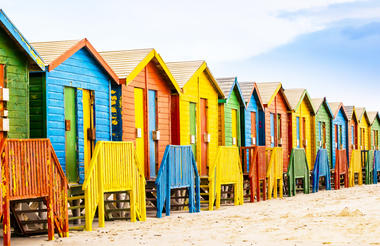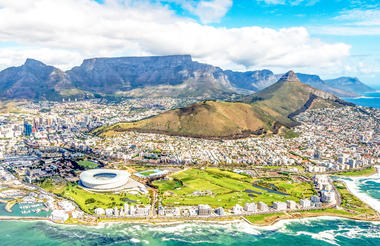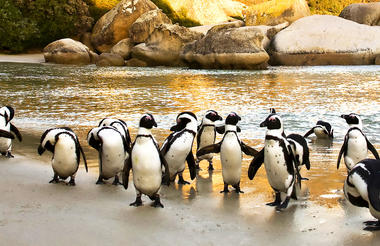Because the Magaliesberg Mountains are almost 100 times older than Mount Everest and half the age of the earth, it is a unique treasure. For its age, and its amazing richness in important fossils, rock art and unique beauty, the Magaliesberg Biosphere was proclaimed an International Biosphere Reserve by UNESCO.
Stretching for approximately 120kms, from Bronkhorstspruit Dam east of Pretoria to Rustenburg, the Magaliesberg Mountains in northern South Africa may not be the longest or the highest mountain range on planet Earth, but they are some of the oldest. And South Africa has some OLD mountains. The Barbertown Greenstone Belt is 3.6 billion years old and are the oldest mountains in the world. The Waterberg Mountains which are 2.7 billion years old are the 3rd oldest mountain range in the world. The Magaliesberg comes in at number 4 at 2.3 billion years. Over millennia, the mountains have been worn down by weather and nature itself. Its highest point, Nooitgedacht, is about 1,852 metres.
With a span of that many years, it’s not surprising that the mountains have seen nearly all of man’s evolution. Fossil evidence of the earliest hominin species, such as Mrs Ples and Little Foot, shows that humans have lived here as far back as 2 million years. Both of these were found in the Sterkfontein Caves, close to the town of Magaliesberg and in the Cradle of Humankind World Heritage Site. The Magaliesberg mountains were also fought over by the Zulus, and later the Boers and the British. The remnants of British blockhouses can still be seen.
The mountains’ natural history began as sediments deposited in an inland basin. Molten magma welled up pushing the sediments down at an angle. The sediments cracked and were themselves filled by a different magma. This was, over time, eroded, forming the deep ravines in which the rock-climbers of today delight. The Magaliesberg is characterized by large quartzite cliffs, deep tree-filled gullies, and stunning waterfalls. Even if you’re not a rock-climber you can enjoy this natural beauty thanks to the cable-car that starts from the Hartbeespoort Dam and takes you to the top. This dam and the mountain range have now become a popular weekend and holiday spot thanks to its proximity to Johannesburg, Rustenburg, and Pretoria. You can tackle some rock-climbing, gaze in awe at the rock art, take a slow wander along the Crocodile Meander, visit any of the small game reserves scattered along the length of the range, including the nearby Kgaswane Mountain Reserve.






Set high on the escarpment, the Mpumalanga Highlands feature endless savannah plains meeting steep mountain passes hugging rugged rocky cliffs. The Highlands of Mpumalanga are a playground for nature and adventure lovers. A number of charming, high-altitude, grassland villages are scattered on a sea of cattle ranches which are interspersed with numerous trout fishing locations and mountain hideaways. Aside from the trout and quaint towns the highland scenery and flora and fauna are also major attractions. Visitors can enjoy a number of wonderful activities including: discovering crystal-clear streams and cascading waterfalls, visiting the Highland’s tourism mecca of Dullstroom, as well as horse riding, whiskey and beer tasting, hiking, fly fishing and much more.






The Mluwati Concession is a 10 000 hectare private reserve hidden in the wilderness of Mpumalanga’s renowned Kruger National Park. Characterised by a sweeping landscape of bushwillows, acacias, open grassland, the N’waswitsontso River, and the eponymous Mluwati River, the concession is a nature lover’s and photographer’s paradise and provides an important protected habitat for a large lion population. Visitors can enjoy game drives and view an array of wildlife including leopard, wild dog, zebra, cheetah, elephant, buffalo, impala, giraffe, and wildebeest. The area also teems with hundreds of bird species including the southern yellow-billed hornbill, the crested barbet, and Burchell’s glossy starling. Ask a guide to tell you about the intriguing lost treasure of ‘Qugunyan's Fortune’ - an abandoned fortune of gold, diamonds, and coins with a fascinating story attached to it.

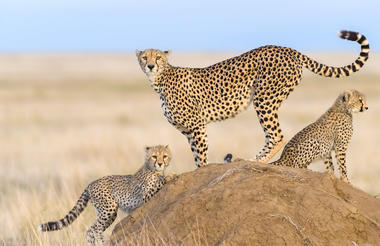




The Smoke that Thunders - it sounds like something out of a legend. But this is no legend told from one generation to another. Mosi-oa-Tunya, Seongo, Chongwe, the Place of the Rainbow, Victoria Falls – it doesn’t matter what you call it, this dramatic natural phenomena speaks for itself. It’s powerful roar and rising spray can be heard and seen over 40kms away.
Here, in the heart of Africa, dividing Zambia and Zimbabwe, is the greatest falling curtain of water on Earth, 1708m wide and 125m high. One of the Seven Natural Wonders of the World, it’s formed by the mighty Zambezi River. Over centuries the river has carved a unique,150km long pattern of gorges through the basalt rock and sandstone on its way to the Indian Ocean. Never silent or still the Falls are now creating a new gorge at the Devil’s Cataract.
There are many ways to experience the power and beauty of the Falls. Part of their uniqueness is that you can revel in the same view from both Zimbabwe and Zambia. But it’s only from Zambia that you can have the adventure of a lifetime – a wild, white water ride that begins in the Boiling Pot. Almost at the foot of the crashing cascade of water where a massive whirlpool swirls in thunder and foam is the first of a series of Class 5 rapids enjoyed by the brave-at-heart rafters and kayakers from all over the world.
Livingstone Island and Devil’s Pool, right on the edge of the Falls, and so dangerous that access is limited to the low water season, are other features which can only be enjoyed from the Zambian side.
In 1855, David Livingstone, Scottish missionary, and explorer, standing on what came to be known as Livingstone’s Island, said, “Scenes so lovely must have been gazed upon by angels in their flight." If you’d like to see what angels do, there is always bungie jumping from the bridge, zip-lining, and bridge swinging!
For those who prefer to keep their feet on the ground, a walk along the paved paths and Knife-Edge Bridge, and through the narrow and utterly unique eco-system of the Victoria Falls rain forest, will open up a mist-shrouded vista of power, beauty, double rainbows, and occasionally moonbows, all with the thunderous rumble underfoot is the best, awe-inspiring option.
The Zambezi River is perfect for sunset boat cruises and game viewing. For some local colour, you can browse through the vibrant Livingstone Market.
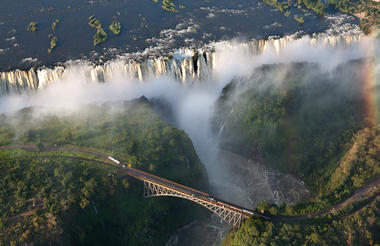
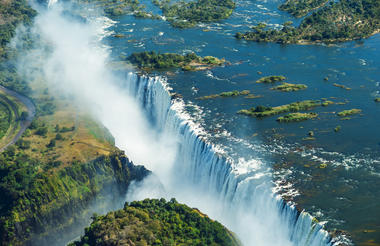
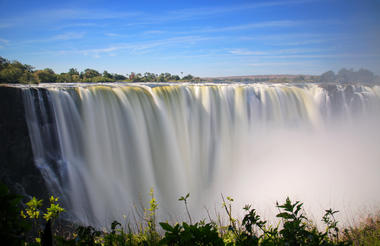
The dazzling, deep blue Chobe River, while protecting the 10 700 km2 of the northern Kalahari Desert, runs for 60kms through the Chobe National Park. It is the lifeblood of this vast, sometimes dry region. Along its shores are areas of sandy terrain, lush floodplains, dense forests of cathedral mopane trees, and seemingly endless broadleaf woodlands. All of which are home to one of the largest concentrations of game in Africa. Massive elephant herds with some of the largest elephants on the continent migrate here from the Caprivi Strip in Namibia, and the Zambezi floodplains of Zambia and Zimbabwe, as well as huge herds of Cape Buffalo. The river can often be the best place to watch game. Animals can be seen on the riverfront all year, but during the dry season, especially in September and October, their numbers can grow enormously.
Hippos, crocodiles and leguvaans which can grow up to 1,5M in length, are some of the obvious creatures to be seen. But all the animals come down to the river to drink. You may see baboon, gentle giraffe, hyena, lechwe, impala, majestic kudu, puku and sable along the river’s edge. Even solitary leopards may be found lapping there, as well as warthog, waterbuck, the rare painted wild dog, blue wildebeest, and zebra. With so much game concentrated in one place the chances of seeing predators like lion hunting for a meal are high.
With the haunting cry of the African fish eagles as the soundtrack, the river front can also be the perfect place for twitchers. Bird lovers will delight in the over 450 species of bird that live here. Among them are storks, wire-tailed swallows, bee-eaters. and the stunning white-backed night herons.
The Serondela area in the north-east, otherwise known as the Chobe Riverfront, can provide some of the best animal interactions you’ll ever see whether you’re in a houseboat, a motorboat or in a 4x4 driving along the banks. Chobe National Park can quite legitimately lay claim to being one of the best national parks in Africa. Its beauty is unparalleled thanks to its wide variety of landscape and its abundance of game.
Resting at the feet of the Boland Mountains in South Africa’s Western Cape Province, the Cape Winelands area is renowned for producing some of the world’s finest wines. The enthralling mountainous landscape boasts an impressive list of luxury wine farms, stretching across lush fertile valleys. Visitors can look forward to a variety of wonderful activities suited to all types of travellers. Explore a collection of historic little hamlets and towns dotting the countryside, sample a wide selection of world-class wine at historic Cape Dutch farmsteads and other wine estates; and make your way through a sublime network of hiking and biking trails. The culinary scene here is world-class and constantly improving; visitors who don’t drink alcohol will also enjoy discovering this destination as part of a ‘food tour’ - numerous superb restaurants are on offer.






The Western Cape, arguably the most scenic and varied of South Africa's nine provinces, serves as a major drawcard for visitors to South Africa. Located in the southwest corner of the country, the province is blessed with stunning coastlines, breathtaking mountains, indigenous forests, historic wine estates and scorched stretches of strikingly beautiful semi-desert. Visitors can enjoy everything from the magnificent city of Cape Town with its iconic Table Mountain and gorgeous surrounding Winelands, to the exhilarating outdoor activities and spectacular natural scenery of the Garden Route, as well as the fynbos-covered sand dunes, sun-bleached beaches and remote fishing villages of the lesser-explored West Coast region. The Western Cape has just about everything that the rest of the country can offer, all rolled into one easy explorable destination.

